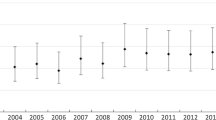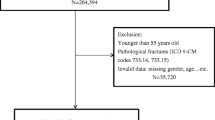Abstract
This study investigated the current incidence of hip fractures in Okinawa prefecture and compared the data with those obtained in our previous study, which was conducted using similar methods in 1987/1988. All patients, aged 50 years or older and residing in Okinawa, admitted to Okinawa hospitals in 2004 for a fresh hip fracture were identified from hospital registries. Details were obtained from the medical records and radiographs of all patients and classified according to fracture type (cervical or trochanteric), age, sex, and fracture location. Subtrochanteric fractures and pathological fractures were excluded. A total of 1,349 patients (242 men and 1,107 women) were admitted for a fresh hip fracture in 2004. Their average age was 76.9 years for men and 82.4 years for women. There were 671 cervical fractures, 654 trochanteric fractures, and 24 unclassified proximal femoral fractures. Comparing the data from 1987/1988 to those from 2004, the total number of hip fractures increased by 188%, from 469 to 1,349. The age-adjusted incidence rates per 100,000, standardized to the 2000 US population, were 75.7 and 296.1 in 1987/1988 and 123.6 and 420 in 2004 for men and women, respectively. The incidence rates in all age groups (at 5-year intervals) were higher in 2004 than in 1987/1988, indicating that people 50 years of age or older became more susceptible to hip fractures. Accordingly, the accretion of the hip fracture incidence rate was greater than that which could be explained purely by changes in population size and structure.


Similar content being viewed by others
References
Melton LJ 3rd (2003) Adverse outcomes of osteoporotic fractures in the general population. J Bone Miner Res 18:1139–1141
Farahmand BY, Michaëlsson K, Ahlbom A, Ljunghall S, Baron JA (2005) Survival after hip fracture. Osteoporos Int 12:1583–1590
Tsuboi M, Hasegawa Y, Suzuki S, Wingstrand H, Thorngren KG (2007) Mortality and mobility after hip fracture in Japan: a ten-year follow-up. J Bone Joint Surg Br 89:461–466
Johnell O, Kanis JA (2006) An estimate of the worldwide prevalence and disability associated with osteoporotic fractures. Osteoporos Int 12:1726–1733
Melton LJ 3rd (1996) Epidemiology of hip fractures: implications of the exponential increase with age. Bone 18(3 Suppl):121S–125S
Cummings SR, Melton LJ 3rd (2002) Epidemiology and outcomes of osteoporotic fractures. Lancet 359:1761–1767
El Maghraoui A, Koumba BA, Jroundi I, Achemlal L, Bezza A, Tazi MA (2005) Epidemiology of hip fractures in 2002 in Rabat, Morocco. Osteoporos Int 16:597–602
Clark P, Lavielle P, Franco-Marina F, Ramírez E, Salmerón J, Kanis JA, Cummings SR (2005) Incidence rates and life-time risk of hip fractures in Mexicans over 50 years of age: a population-based study. Osteoporos Int 16:2025–2030
Lesić A, Jarebinski M, Pekmezović T, Bumbasirević M, Spasovski D, Atkinson HD (2007) Epidemiology of hip fractures in Belgrade, Serbia Montenegro, 1990–2000. Arch Orthop Trauma Surg 127:179–183
Shao CJ, Hsieh YH, Tsai CH, Lai KA (2009) A nationwide seven-year trend of hip fractures in the elderly population of Taiwan. Bone 44:125–129
Giversen IM (2006) Time trends of age-adjusted incidence rates of first hip fractures: a register-based study among older people in Viborg County, Denmark, 1987–1997. Osteoporos Int 17:552–564
Jaglal SB, Weller I, Mamdani M, Hawker G, Kreder H, Jaakkimainen L, Adachi JD (2006) Population trends in BMD testing, treatment, and hip and wrist fracture rates: are the hip fracture projections wrong? J Bone Miner Res 20:898–905
Newman ED, Ayoub WT, Starkey RH, Diehl JM, Wood GC (2003) Osteoporosis disease management in a rural health care population: hip fracture reduction and reduced costs in postmenopausal women after 5 years. Osteoporosis Int 14:146–151
Kannus P, Niemi S, Parkkari J, Palvanen M, Vuori I, Järvinen M (2006) Nationwide decline in incidence of hip fracture. J Bone Miner Res 21:1836–1838
Bjørgul K, Reikerås O (2007) Incidence of hip fracture in southeastern Norway: a study of 1,730 cervical and trochanteric fractures. Int Orthop 31:665–669
Willcox BJ, Willcox DC, Suzuki M (2001) The Okinawa Program: how the World’s longest-lived people achieve everlasting health and how you can too. Three Rivers Press, New York
Yoshikawa T, Norimatsu H (1991) Epidemiology of osteoporosis in Okinawa. J Bone Miner Metab 9(Suppl):135–145
Lönnroos E, Kautiainen H, Karppi P, Huusko T, Hartikainen S, Kiviranta I, Sulkava R (2006) Increased incidence of hip fractures. A population based-study in Finland. Bone 39:623–627
Yan L, Zhou B, Prentice A, Wang X, Golden MH (1999) Epidemiological study of hip fracture in Shenyang, People’s Republic of China. Bone 24:151–155
de Pina MF, Alves SM, Barbosa M, Barros H (2008) Hip fractures cluster in space: an epidemiological analysis in Portugal. Osteoporos Int 19:1797–1804
Yoshimura N, Suzuki T, Hosoi T (2005) Epidemiology of hip fracture in Japan: incidence and risk factors. J Bone Miner Metab 23(Suppl):78–80
Dargent-Molina P, Favier F, Grandjean H, Schott A M, Hausherr E, Meunier P J, Bréart G, for EPIDOS Group (1996) Fall-related factors and risk of hip fracture: the EPIDOS prospective study. Lancet 348:145–149
Matsuueda M, Ishii Y (2000) The relationship between dementia score and ambulatory level after hip fracture in the elderly. Am J Orthop 29:691–693
Moayyeri A, Soltani A, Larijani B, Naghavi M, Alaeddini F, Abolhassani F (2006) Epidemiology of hip fracture in Iran: results from the Iranian Multicenter Study on Accidental injuries. Osteoporos Int 17:1252–1257
Morita Y, Endo N, Iga T, Tokunaga K, Ohkawa Y (2002) The incidence rate of cervical and trochanteric fractures of the proximal femur in 1999 in Niigata Prefecture, Japan. J Bone Miner Metab 20:311–318
Hagino H, Katagiri H, Okano T, Yamamoto K, Teshima R (2005) Increasing incidence of hip fracture in Tottori Prefecture, Japan: trend from 1986 to 2001. Osteoporos Int 16:1963–1968
Takasu N, Yogi H, Takara M, Higa M, Kouki T, Ohshiro Y, Mimura G, Komiya I (2007) Influence of motorization and supermarket-proliferation on the prevalence of type 2 diabetes in the inhabitants of a small town on Okinawa, Japan. Intern Med 46:1899–1904
Shimabukuro M (2009) “26 shock” and management to the metabolic syndrome in Okinawa (in Japanese). Pharma Medica 27:67–72
Michaëlsson K, Weiderpass E, Farahmand BY, Baron JA, Persson PG, Zidén L, Zetterberg C, Ljunghall S (1999) Differences in risk factor patterns between cervical and trochanteric hip fractures. Osteoporos Int 10:487–494
Mautalen CA, Vega EM (1993) Different characteristics of cervical and trochanteric hip fractures. Osteoporos Int (Suppl):102–106
Mautalen CA, Vega EM, Einhorn TA (1996) Are the etiologies of cervical and trochanteric hip fractures different? Bone 18(Suppl):133S–137S
Löfman O, Berglund K, Larsson L, Toss G (2002) Changes in hip fracture epidemiology: redistribution between ages, genders and fracture types. Osteoporos Int 13:18–25
Takada J, Beck TJ, Iba K, Yamashita T (2007) Structural trends in the aging proximal femur in Japanese postmenopausal women. Bone 41:97–102
Hernández JL, Olmos JM, Alonso MA, González-Fernández CR, Martínez J, Pajarón M, Llorca J, González-Macías J (2006) Trend in hip fracture epidemiology over a 14-year period in a Spanish population. Osteoporos Int 17:464–470
Acknowledgments
We would like to thank Dr. Tomoaki Yoshikawa of Nishizaki Hospital for his valuable discussion of fracture assessment. This work was supported in part by the Japanese Ministry of Education, Culture, Sports, Science, and Technology.
Author information
Authors and Affiliations
Corresponding author
About this article
Cite this article
Arakaki, H., Owan, I., Kudoh, H. et al. Epidemiology of hip fractures in Okinawa, Japan. J Bone Miner Metab 29, 309–314 (2011). https://doi.org/10.1007/s00774-010-0218-8
Received:
Accepted:
Published:
Issue Date:
DOI: https://doi.org/10.1007/s00774-010-0218-8




